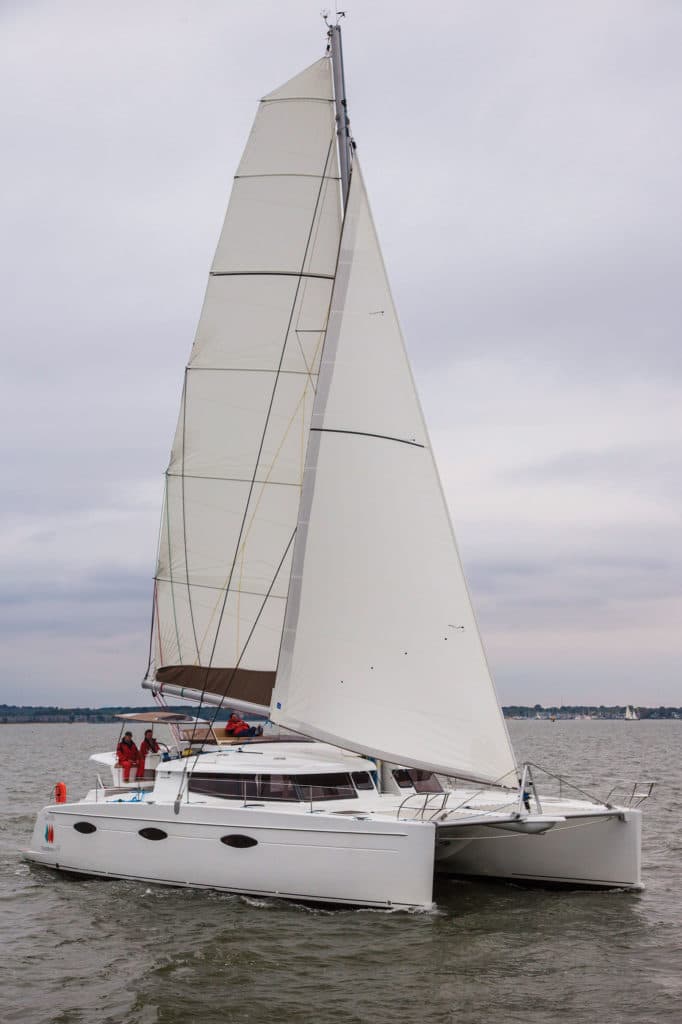
Fountaine Pajot Sanya 57
A benefit to tagging along on sea trials with Cruising World’s Boat of the Year judges—apart from the wealth of knowledge you gain—is that you don’t actually have to do all the sailing. And so it was that on a gray day last fall following the U.S. Sailboat Show in Annapolis, Maryland, after I’d done my trick at the wheel and finished jotting down notes, I found myself comfortably stretched out atop the lounge deck of the new Fountaine Pajot Sanya 57. For the record, the view was spectacular and the ride could only have been more enjoyable had the sun come out and warmed things up by 20 degrees or so.
The Sanya was built to take a crowd sailing, and measured by that design brief, Olivier Racoupeau of Berret Racoupeau Yacht Design hit the target square on. With accommodations for five couples (and three crew if desired), the French-built cat has room to spare; in fact, more living space than the Eleuthera 60, which it replaces in F.P.’s Flagship Class of cruising catamarans. And on the sailing side of the equation, a powerful, flat-topped, full-batten equipment room buried in the nacelle. Once inside, the skipper has clear access to the various switches and 12- and 24-volt circuits that power the Sanya’s systems. But without removing the screwed-down nav station seat, BOTY judge Ed Sherman found he turned into a contortionist of sorts as he wormed his way in, a feat that would have been all the more difficult in any kind of seaway.
The Sanya’s interior has an elegant feel, thanks to a rich mix of light and dark colors and large ports that provide an expansive view. The island counter is ideal for entertaining and cooking.
An L-shaped settee and low-slung coffee table take up the saloon’s port side. Opposite, an island counter sets off a galley (dishwasher, stove, oven, microwave and full-size double-door fridge) that you’d expect to find on a $1.2 million catamaran.
There are a couple of options for living accommodations. The boat we sailed was the Quintet version, with five double cabins with private heads and showers: three in the port hull, and fore and aft in the starboard hull. A single-berth (captain’s) cabin was amidships to starboard. Fore and aft companionways in each hull provide cabin access without having to troop through anyone else’s space. Two additional crew berths are located in the bows.
In the Maestro version, the owner gains an enormous cabin and separate head and shower, aft in the port hull, with a guest cabin forward.
Fountaine Pajot has been building boats since 1976, and its construction techniques have evolved with the technology available. The Sanya’s hulls and deck are resin infused and balsa cored; the cockpit bimini is injection molded, producing a finished surface top and bottom.
Plenty of power is provided by a square-topped main and overlapping genoa. The Sanya comes in two different layouts, including the six-cabin version (above) that would work well in charter service
Twin 110-horsepower Volvo engines powered the boat we sailed (75-horsepower engines come standard). With 300 gallons of fuel, the Sanya should have the auxiliary wherewithal to be a long-legged cruiser. But why motor when you can sail? And considering the four 170-watt solar panels incorporated into the bimini,the builder notes you may not need to run those engines to top off the batteries, either.
Whether the intent is to enter this catamaran into charter service or simply allow owners to lavishly entertain family and friends, the Sanya sets sail in a grand way.
Click here to see more boats from Fountaine Pajot.
This article first appeared in the August 2013 issue of Cruising World.








